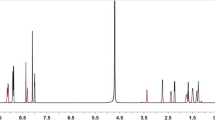Abstract
As part of our research efforts in the area of titanium-based antitumor agents, we have investigated the cytotoxic activity of [Ti4(maltolato)8(μ-O)4], (Cp-R)2TiCl2 and (Cp-R)CpTiCl2 (R = CO2CH3 and CO2CH2CH3), and three water-soluble titanocene–amino acid complexes—[Cp2Ti(aa)2]Cl2 (aa = l-cysteine, l-methionine, and d-penicillamine)—on the human colon adenocarcinoma cell line, HT-29. The capacity of [Ti4(maltolato)8(μ-O)4] to donate Ti(IV) to human apo-transferrin and its hydrolytic stability have been investigated and compared to the previously reported data on modified titanocenes with either hydrophilic ancillary ligands or the functionalized cyclopentadienyl ligands. Notably, the titanium–maltolato complex does not transfer Ti(VI) to human apo-transferrin at any time within the first seven days of its interaction, demonstrating the inert character of this species. Stability studies on these complexes have shown that titanocene complexes decompose at physiological pH while the [Ti4(maltolato)8(μ-O)4] complex is stable at this pH without any notable decomposition for a period of ten days. The antitumor activity of these complexes against colon cancer HT-29 cells was determined using an MTT cell viability assay at 72 and 96 h. The titanocene–amino acid and the (Cp-R)2TiCl2/(Cp-R)CpTiCl2 (R = CO2CH3) complexes were not biologically active when human transferrin was absent; they also were inactive when human transferrin was present at dose-equivalent concentrations. (Cp-R)2TiCl2 and (Cp-R)CpTiCl2 (R = CO2CH2CH3) showed cytotoxic activity in HT-29 cells comparable to that which is displayed by titanocene dichloride. The titanium–maltolato complex had higher levels of cytotoxic activity than any other titanocene complex investigated. Transferrin may be important in protecting the titanium center from hydrolysis, but this may be achieved by selecting ligands that could result in hydrolytically stable, yet active, complexes.





Similar content being viewed by others
References
Köpf-Maier P (1994) Eur J Clin Pharmacol 47:1
Köpf-Maier P, Köpf H (1988) Struct Bonding 70:103
Köpf-Maier P, Köpf H (1987) Chem Rev 87:1137
Köpf-Maier P, Köpf H (1994) In: Fricker SP (ed) Metal compounds in cancer therapy, organometallic titanium, vanadium, niobium, molybdenum and rhenium complexes—early transition metal antitumor drugs. Chapman & Hall, London, pp 109–146
Harding MM, Mokdsi G (2000) Curr Med Chem 7:1289
Meléndez E (2002) Crit Rev Oncol Hematol 42:309
Toney JH, Marks TJ (1985) J Am Chem Soc 107:947
Boyles JR, Baird MC, Campling BG, Jain N (2001) J Inorg Biochem 84:159
Valadares MC, Klein SL, Guaraldo AMA, Queiroz MLS (2003) Eur J Pharmacol 473:191
Allen OR, Croll L, Gott AL, Knox RJ, McGowan PC (2004) Organometallics 23:288
Causey PW, Baird MC, Cole SPC (2004) Organometallics 23:4486
Tacke M, Allen LT, Cuffe L, Gallagher WM, Lou Y, Mendoza O, Mueller-Bunz H, Rehmann F-JK, Sweeney N (2004) J Organomet Chem 689:2242
Rehmann F-JK, Cuffe LP, Mendoza O, Rai DK, Sweeney N, Strohfeldt K, Gallagher WM, Tacke M (2005) Appl Organomet Chem 19:293
Sweeney NJ, Mendoza O, Müller-Bunz H, Pampillón C, Rehmann F-JK, Strohfeldt K, Tacke M (2005) J Organomet Chem 690:4537
Gansäuer A, Franke D, Lauterbach T, Nieger M (2005) J Am Chem Soc 127:11622
Kelter G, Sweeney NJ, Strohfeldt K, Fiebig H-H, Tacke M (2005) Anti Cancer Drugs 16:1091
Valadares MC, Ramos AL, Rehmann F-JK, Sweeney NJ, Strohfeldt K, Tacke M, Queiroz MLS (2006) Eur J Pharmacol 534:264
Fichtner I, Pampillon C, Sweeney NJ, Strohfeldt K, Tacke M (2006) Anti Cancer Drugs 17:333
Meléndez E, Marrero M, Rivera C, Hernández E, Segal A (2000) Inorg Chim Acta 298:176
Pérez Y, López V, Rivera-Rivera L, Cardona A, Meléndez E (2005) J Biol Inorg Chem 10:94
Gao L, Hernández R, Matta J, Meléndez E (2007) J Biol Inorg Chem 12:959
Guo M, Sun H, McArdle HJ, Gambling L, Sadler PJ (2000) Biochemistry 39:10023
Messori L, Orioli P, Banholer V, Pais I, Zatta P (1999) FEBS Lett 422:157
US Patent application number 60987915. 14 November, 2007
Lamboy JL, Pasquale A, Rheingold AL, Meléndez E (2007) Inorg Chim Acta 360:2115
Harstrick A, Schmoll H-J, Sass G, Poliwoda H, Rustum Y (1993) Eur J Cancer 29A:1000
Kurbacher CM, Bruckner HW, Andreotti PE, Kurbacher JA, Saβ G, Krebs D (1995) Anti Cancer Drugs 6:697
Rehmann F-J, Rous AJ, Mendoza O, Sweeney NJ, Strohfeldt K, Gallagher WM, Tacke M (2005) Polyhedron 24:1250
Pampillón C, Sweeney NJ, Strohfeldt K, Tacke M (2007) J Organomet Chem 692:2153
Mossman T (1983) J Immunol Methods 65:55
Denizot F, Lang R (1986) J Immunol Methods 89:271
Caruso F, Rossi M (2004) Mini Rev Med Chem 4:49
Caruso F, Rossi M, Tanski J, Sartori R, Sariego R, Moya S, Diez S, Navarrete E, Cingolani A, Marchetti F, Pettinari C (2000) J Med Chem 43:3665
Keppler BK, Friesen C, Moritz HG, Vongerichten H, Vogel E (1991) Struct Bonding 78:98
Acknowledgments
Enrique Meléndez acknowledges the NIH-MBRS SCORE Programs at both the University of Puerto Rico Mayagüez and the Ponce School of Medicine for financial support via NIH-MBRS-SCORE Program grant #S06 GM008239-23 and the PSM-Moffitt Cancer Center Partnership 1U56CA126379-01. In addition, Enrique Meléndez thanks the NSF-MRI Program for providing funds for the purchase of the 500 MHz NMR instrument and to the Sloan Foundation for financial support in the form of a graduate fellowship to Ramón Hernández. Finally, Jaime Matta would like to thank Bob Ritchie, RCMI Program Grant #RR003050-23, for his help in the editing of this manuscript.
Author information
Authors and Affiliations
Corresponding author
Electronic supplementary material
Below is the link to the electronic supplementary material.
Rights and permissions
About this article
Cite this article
Hernández, R., Lamboy, J., Gao, L.M. et al. Structure–activity studies of Ti(IV) complexes: aqueous stability and cytotoxic properties in colon cancer HT-29 cells. J Biol Inorg Chem 13, 685–692 (2008). https://doi.org/10.1007/s00775-008-0353-z
Received:
Accepted:
Published:
Issue Date:
DOI: https://doi.org/10.1007/s00775-008-0353-z




